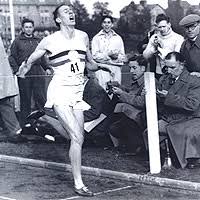In 1954, the sports world was shocked when Great Britain’s Roger Bannister broke the four minute-mile barrier by six tenths of a second. For years, track and field experts and enthusiasts claimed that breaking 4 minutes was impossible. However, less than six weeks later, the Australian John Landy bested the new record time by more than a second. Bannister’s accomplishment not only cracked the mile time, he also changed the belief system that one could run four laps of the track faster than thought humanly possible. His efforts renewed a sense of optimism and resilience that has eventually brought the record down to 3:43.13 – set in 1999 by Morrocco’s Hicham El Guerrouj.
Bannister’s crowning achievement was only the tip of the iceberg in pressing the envelope of human performance. Five decades later, the bar has increased in not only sports, but in the enterprises of business, education, health care, and the legal system. As people more quickly adapt to achievements, expectations increase. This is the legacy of the “hedonic treadmill.” The development of expertise sets comes through trial and error until the skill becomes a habit and a person performs within their respective enterprise with machine-like precision. However, we are all imperfect human beings and not mechanistic automatons.
John Corlett, of MacEwan University, paints a compelling illustration about human potential in an article entitled, The Red Queen Effect: Avoiding Life’s Treadmill. Corlett quotes the character of the Red Queen in Lewis Carroll’s Through the Looking Glass. The Red Queen says to Alice that “it takes all the running you can do to keep in the same place. If you want to get somewhere else, you must run at least twice as fast as that!” This sounds very familiar in keeping up with the today’s “speed of life.”
Corlett draws an important parallel from what the Red Queen says. He claims, “In biology, the evolution of relationships that evolve between predators and their prey has been known as the Red Queen effect. Any adaptation in a prey species is matched in subsequent generations by counter-adaptations in predator species. As the hunted become faster and more agile, so are those that hunt them. This arms race escalates in perpetuity, with neither side ever able to gain sufficient advantage to be safe from the threat of being eaten or starved to extinction.”
The predator/prey relationship is alive and well in competitive sports today. It is inevitable. There is no solution, but there are a variety of strategies coaches can use to mitigate the negative effects of an overfocus on performance through managing “getting the job done” and “building relationships.”
Darrell Knowlton is the rugby coach at the Culver Academies (IN). At Culver, he wanted to help the boys keep their dream alive of playing rugby. “We got really good and had a bunch of really good athletes, and I started valuing performance over process. When I hung onto valuing performance over process, there was a lot of disappointment that ruined some love of the game for the athletes and ruined some of my love for coaching. It wasn’t that we had a bad culture, but I got away from who I am as a person, as a coach, and as a mentor of young people in trying to keep pace with other strong teams.
Fortunately, Darrell had a crucible moment of honest feedback about his coaching style. It was a Sunday afternoon, when he was in the weight room working out along with John Buxton, the Culver’s Head of School, and his wife. Mr. Buxton said to Darrell, “Has anyone talked with you yet about how we feel you’re not at your best?” Darrell replied, “No, but I have a feeling we’re going to do it right now.’ John said, “We’ve watched you over the years. You’re an excellent coach, and you’re great for the kids. But some of the things we’ve seen in the last season and a half are not you.” He went on, ‘Stop trying to have the next high-performance program because that’s not who you are. You are process focused. You are player centered. You are holistic development oriented. Get back to who you are at your best as a coach.” That is when Darrell started going back to managing process and performance. He then started employing more strategies to build relationships among the players through more consciously building trust, expressing empathy, and showing every athlete that they matter.
As a coach, how do you navigate the influence of the Red Queen Effect on your teams? What strategies do you have to foster relationships among your players?
The Red Queen could learn a thing or two by building healthy relationships. That would be very instructive for Alice, as well as for all coaches?

